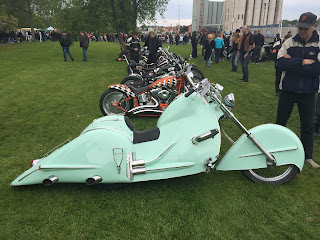I know I said something about digging into the geometry of the frame and angles. I did some of it but never wrote about it. Mostly because I didn't bother to draw any pictures or do any real math - but here is some of the thinking I did.
Let's start with a pic that I took from the tool that knowledgeable people nearby have made.
There are three different measures that typically are discussed; First one is called trail and is the measure J in the pic. It is the distance between the point where imaginary continuation of steering axle hits the ground and the point where the tyre touches the ground.
Bearded wise men, much like Gandalf, can tell that about 10cm of trail is good. If the trail is less the steering becomes volatile and if it's too much the bike becomes heavy to handle. Heavy meaning that it's almost too stable at the middle but there may be a sudden kink at certain angle where steering collapses to a side. So, as many times is in life, too little is as bad and so is too much, but for different reason.
While we try to aim in getting the trail to close to the magical 10cm we have some freedom of choice. We have chosen the tyres already so those measures are fixed. But if we stretch the front we can adjust the height of the steering axel top from the ground. I'm not going to do that because I don't have to. If I was making a chopper then it would be inevitable. But we still have couple of things left we can adjust - the rake angle, which is the angle between the steering axle and fork and the offset of steering axel and fork neck.
The measures in the picture are somewhat close to what makes sense but not final for my bike. I will have to see the rake angle in its place when the rest of the frame is ready.
But the million dollar question I was pondering on was that why exactly in mathematical sense the trail needs to be something and what is the physics behind when it is wrong? There are two main reasons why bikes can be ridden at higher speeds to begin with. The explanation typically given in the driving schools, or at least given to me, is the precession - i.e. momentum related to rotating object and it's reluctancy to change it's position. Fine, I buy that and it is part of the reason but not the whole truth. You can try this with an old fashioned bike that has fork with a little angle there in between -- turn the handlebar 180 degrees and try driving that bike. I bet you a beer that you will be eating grass in a minute (try it on grass and not on paved road for the sake of your health).
What I'm trying to say is that when bike moves, there are other forces in to action than just the precession. One main thing is the dragging force of the front wheel and the line of action compared to the point around which the wheel actually turns. And the point around which the wheel actually tries to turn is not really where the wheel touches the ground but the line of steering axel. This is easy to understand and see if you lift the front into the air -- steering axel is the rigid part attached to the frame around which the whole moving part of front tries to revolve around.
So loosely speaking the momentum that will try to turn the wheel back to center line after displacement and around the steering axle is dependent on the distance of between the two points - the trail. At the extreme if trail would be negative it would mean that the whole set up is labile. Much like balancing pencil on your finger tip in upright position compared to keeping it in the same position by hanging it from the upper end. But this is not exact explanation and I'm not going to do the math. Not at least right now but maybe some day.
















